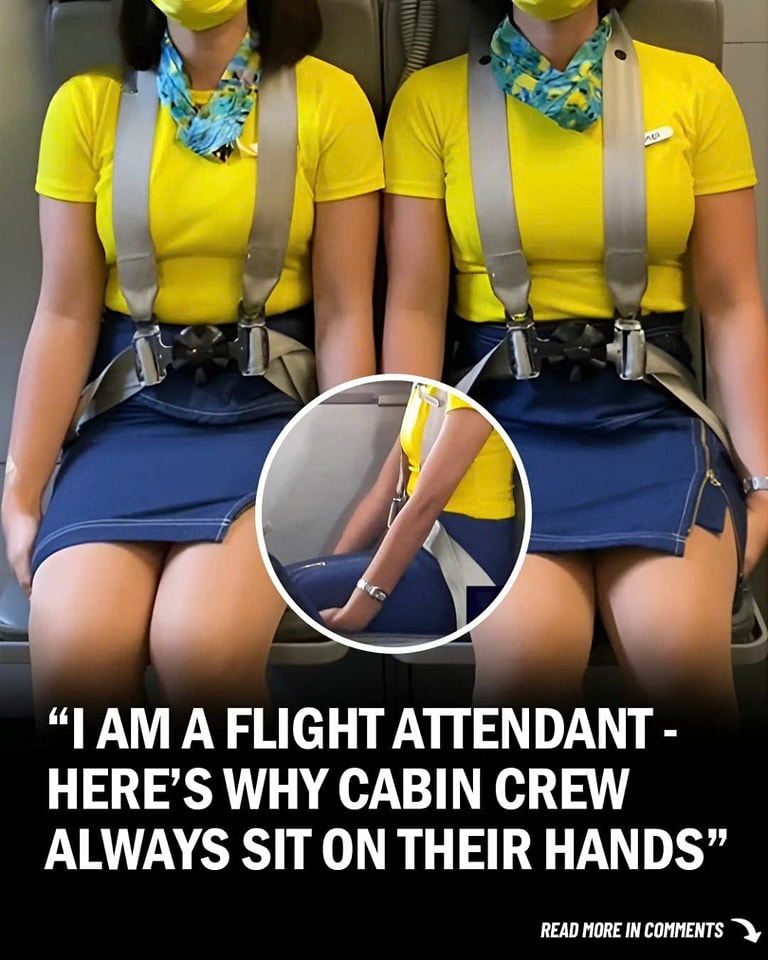When boarding a plane, passengers may notice flight attendants seated in their jumpseats during takeoff and landing, often sitting upright with their hands resting on their laps or even tucked under their thighs. For years, curious flyers have speculated about this posture. Is it for relaxation? A secret signal? Or something more?
According to experienced cabin crew members, this practice is far from casual—it’s a deliberate safety technique known as the “bracing position” or “hands under thighs posture,” essential for both personal safety and emergency preparedness.
The Real Reason Behind the Posture
As explained by several flight attendants, including those who have shared their insights through training organizations and viral social media videos, the practice of sitting on their hands is a precaution designed to reduce injury risk during sudden impact situations. Here’s why:
- Injury Prevention: During takeoff and landing—statistically the riskiest phases of flight—there is an increased risk of abrupt stops or crashes. By placing their hands under their thighs and keeping their feet flat on the floor, flight attendants minimize flailing in case of impact. This reduces the chance of breaking wrists, arms, or suffering other injuries from sudden jolts.
- Brace Position Training: This posture is part of the officially taught “brace position” in flight attendant safety training. Along with keeping their backs straight against the seat and heads tilted slightly forward, sitting on their hands helps maintain a stable body position that can better absorb shock.
- Prepared for Emergency Response: By securing themselves during these critical phases, flight attendants ensure they are physically able to assist passengers if an emergency arises immediately after landing or takeoff. If cabin crew were injured, they wouldn’t be able to fulfill their duties, such as opening doors, directing evacuations, or helping injured passengers.
More Than Just Hands Under Thighs
The full bracing posture also involves:
- Keeping knees together and feet flat against the floor.
- Ensuring shoulder harnesses and seat belts are securely fastened.
- Maintaining a focused, alert mindset—often scanning the cabin for last-minute safety checks.
This disciplined positioning is a visible reminder of the flight attendants’ role as safety professionals first and foremost—not just hospitality staff.

What Aviation Experts Say
Aviation safety consultants confirm that the practice is endorsed by regulatory bodies like the Federal Aviation Administration (FAA) and the International Civil Aviation Organization (ICAO). It’s considered a global standard in airline safety protocols.
Paul Santorini, an aviation safety trainer with over 20 years of experience, explains:
“Flight attendants are not sitting on their hands to look relaxed—they’re protecting themselves. It’s part of industry-standard training to ensure they can assist passengers immediately if needed.”
Passenger Perceptions
Many passengers, unaware of the safety reasoning, have shared puzzled reactions online. One user on a travel forum posted:
“I always wondered why the crew sits so stiff during takeoff. Now I get it—it’s all about being ready for the worst-case scenario.”
Some travelers have even mistaken the posture as a sign of nervousness or discomfort, but in reality, it reflects a high level of professionalism and training.


The Bigger Picture: Cabin Crew as First Responders
While flight attendants are often associated with serving drinks and snacks, their primary role is ensuring passenger safety. This includes handling medical emergencies, evacuations, and maintaining order during in-flight incidents.
The “hands under thighs” practice underscores this responsibility. Flight attendants are the first responders onboard, trained to remain composed and effective in high-stress situations.
Final Thought
So next time you notice flight attendants sitting quietly on their jumpseats with their hands tucked under their thighs, remember: it’s not just a habit or a secret code. It’s a carefully practiced safety measure designed to protect themselves—and ultimately, you.
As passenger aviation continues to prioritize safety, these small yet crucial details make a big difference. It’s another reason to appreciate the professionalism and preparedness of cabin crews around the world.